Without knowing what these cute creatures look like, you can imagine they would be a deep shade of scarlet, similar to the fruit they were named after. The neocaridina davidi or Cherry Shrimp is a freshwater shrimp species native to Taiwan and are often kept in freshwater tanks. Cherry shrimp can actually come in a wide range of colors from brown to green, violet and even blue, but the red color is the most popular; as the name suggests, it most commonly inhabits the red “Cherry” color.
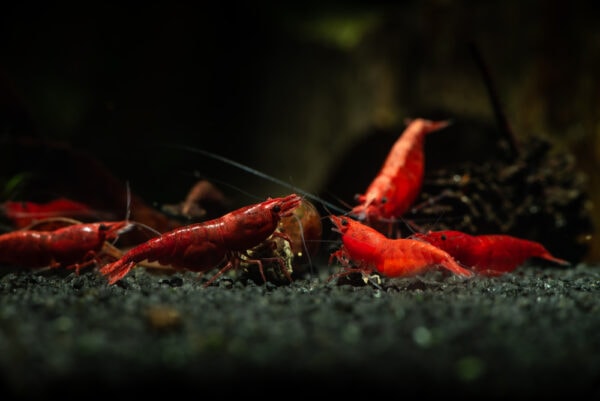
However, you will mostly find the red cherry shrimp on sale at your local aquarium. They’re selectively bred with other species, making them varied and commonly available water species. Unfortunately, it’s all about how bright and appealing the cherry shrimp looks because their color differentiation can fetch different prices for them.
It has a vibrant red color that complements most aquariums’ green plants and the black substrate. Red shrimps are also well known for their snacking on algae habits. So, besides adding depth to your tank’s aesthetics, they are also going to keep it clean.
Table of Contents
Cherry Shrimp Overview
Red shrimps are always fun and rewarding when introduced into your aquarium. Their bright colors are captivating and can inspire you to get hold of more exotic shrimp species.
They are known as tank cleaner-uppers and are quite hardy. These peaceful freshwater shrimps are a wonderful, not to mention colorful addition to any tank.
| Information Chart | Cherry Shrimp |
|---|---|
| Scientific Name | Neocaridina davidi |
| Family: | Atyidae |
| Care Level: | Easy |
| Temperament: | Peaceful |
| Color: | Bright Red |
| Lifespan: | 1-2 years |
| Size: | 3-4 cm |
| Diet: | Omnivore |
| Minimum Tank Size: | 2 gallons |
| Temperature: | 15-30℃ |
| Water Conditions: | Slightly alkaline |
| Tank Mate Compatibility | Peaceful |
Cherry Shrimp Appearance
Interestingly, the female neocaridina davidis are larger than the males. The females are generally about 1.5 inches long. Freshwater cherry shrimp are sought after due to their variety of colors, especially their marbling brown shades. The more red and bright the shrimp is, the more valuable and expensive it is. Just the red-hued shrimp alone can breed deep red shrimps. If it’s breeding with other kinds of species, its juvenile may constitute a few red spots on its exoskeleton.
Let’s look at a few differences between the red cherry shrimps alone.
- The cherry shrimp, the subject of our discussion today, is considered less valuable because they are mostly clear coated with red patches.
- The sakura cherry shrimp is higher and has more clear red patches than the predecessor.
- Fire red shrimp are all red
- Painted fire red shrimp are the highest grade and most sought after. The color can even reach their legs other than their bright all-red bodies.
The neocaridina davidi come in many other colors due to selective breeding:
- Yellow
- Blue
- Green
- Violet
- Black
- White
- Brown
- Ghost – transparent
If you had a little bit of all the colors, you can create a little rainbow in your tank! Females are the ones that are brighter and more vivid in color, and they form a little pouch on their stomachs come breeding time, whereas males do not.
Besides being smaller than the females, male cherry shrimp also possess a narrower tail as they do not need to carry the eggs.
The color of a Cherry Shrimp is very important for grading the quality of the shrimp and gauging its price. Globally, there are four grades used to categorise the shrimps.
High Grade: It’s the highest grade to classify a Cherry Shrimp. The best example of this grade is Painted Fire Red Cherry Shrimp. The entire body of the species is red, including its legs. Understandably, it’s also the costliest of the bunch.
Medium-High Grade- Fire Red Cherry Shrimp, falls under this category. The shrimp has a dark red body. However, the color doesn’t extend to its legs.
Medium Grade- Sakura Cherry Shrimp belongs to this classification. It has a red translucent body with pinkish sakura color.
Lowest Grade- The most basic of cherry shrimps falls under this category. They are of the lowest grade as their bodies lack the color distinct to this species. It only has speckles of red and hence is the cheapest of the bunch.
The Lifespan Of Cherry Shrimp
How long do cherry shrimp live? Although these little creatures do not cost an arm and a leg, you still want them to keep your tank bright and live a happy life for as long as possible. It’s all about the amount of care you give your arthropods.
Red cherry shrimp can live up to a year or a little over 2 years in good conditions. However, some cherry shrimp might not survive the transition from the wild to aquariums as it hampers all the water parameters. And your shrimp might not be able to take the stress of it all. With the careful transition, your red cherry shrimp should have no problem acclimating to their new environment.
Family
Cherry shrimp are indigenous to Taiwan and belong to the atyidae family.
Cherry Shrimp Size
Unlike most other aquarium fish, cherry shrimps don’t grow big. At its maximum, you can expect an adult cherry shrimp to measure up to 4 cm in length. The women of the species are the ones to carry the eggs. For this reason, they tend to be larger than their male counterparts.
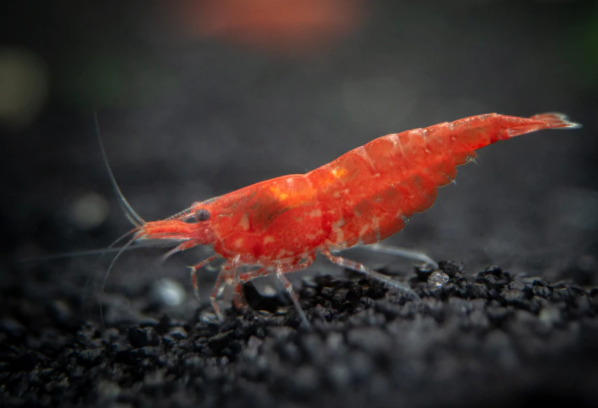
Cherry Shrimp Natural Habitat and Origin
Cherry Shrimp are originally the inhabitants of Taiwan’s freshwater rivers and streams. Thus, you can conclude that they thrive in tropical and slow-moving waters.
Interestingly, in the past few years, aquarists have seen the species prop up in the polluted canals of Poland. However, that’s most likely a result of unplanned release in the water.
Cherry Shrimp Care & Tank Set-Up
When you initially set up the tank, there are a few steps you need to take before introducing the inhabitants to their new home.
Red cherry shrimp (or ones of any color) are very easy to keep. They are known for their low maintenance requirements. Lack of food in the early stages of their development doesn’t seem to do much damage to these beautiful red crustaceans.
You don’t need to follow too many guidelines when caring for these little creatures. How do you take care of cherry shrimp? They will thrive as long as they have fresh water, food, no predators in the tank, and a good environment. Since they are also known as algae eaters, having a planted tank with lots of spots for them to hide ensures their peaceful nature.
All in all, whether you are a beginner aquarist or an experienced one looking to add a pop of color to your tank, the red cherry shrimp will liven and brighten up an aquarium.
One thing to be aware of is that although they are easy to care for, cherry shrimp have a sensitivity to copper, affecting their growth. It means you need to regulate the water conditions to neutralize this mineral along with lead and other metals.
Cherry Shrimp Tank Size and Specifications
Optimum Tank Size for Cherry Shrimp
As you can imagine, the tank size for these tiny invertebrates doesn’t need to be too big – we’re talking 5 gallons for just the cherry shrimp alone. Of course, the size of the tank will need to increase with more inhabitants and the number of shrimp you intend to keep. Opting for a tank that’s too big will always be better than settling for one that’s on the small end.
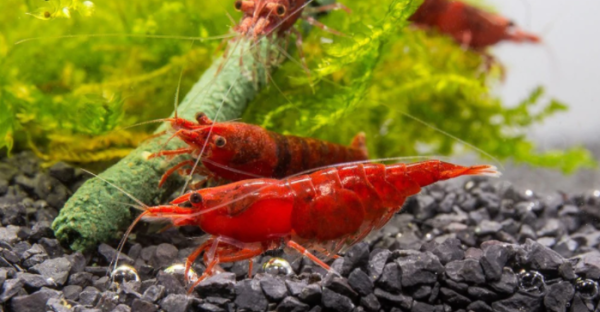
Tank Shape for Sherry Shrimp
The crustaceans don’t have any specific demands for tank shape. Just try to ensure your shrimps get enough space to move around and explore.
Filter Type
There isn’t a need for water heaters in the tank as long as the room is moderately comfortable. It’s not necessary to fear filters if the right kind is used. Sponge filters are less aggressive and won’t hurt your shrimp. Even though they act like tank filters themselves by cleaning up after themselves, it’s nice for your shrimp to have a little bit of help.
Substrate
As with most domesticated animals, cherry shrimp do well in an environment that mimics their natural one. This means they need plenty of dense plants along the substrate, giving them places to hide and burrow in. The plants offer hiding places but are also a source of food.
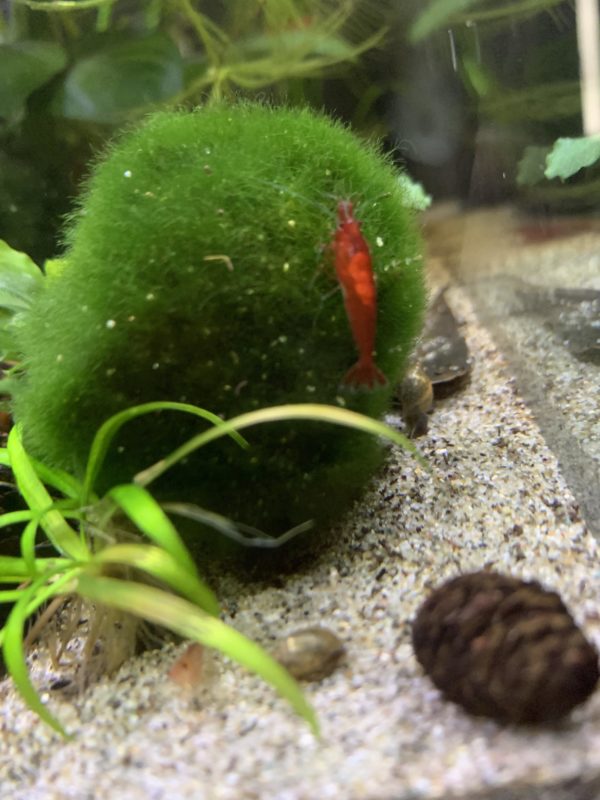
Adding good moss will also create soft bedding for your shrimp to hide in. You can tell how your shrimp are feeling by their coloration. Similar to a dog, their health condition shows through their coat. If your shrimp feel happy and safe, their coloration will be brighter. They tend to blend in with the substrate as well. If you place lighter colored plants and bedding in the tank, your shrimp will lack vividness. They will turn their pigments on full power when their surroundings consist of a darker colored substrate.
It is generally good to rinse the plant substrates and wash the gravel or pebbles before placing them in the aquarium. The water should be at least a foot deep for the shrimp and their tank mates to live comfortably.
How Many Cherry Shrimp Are In A Tank?
One good thing about Cherry Shrimp is that they don’t need much space. That means you can conveniently place five or even six shrimp in a large tank. Although, when you introduce more of these specimens into the tank, avoid cramping them up in a small space. That might make them territorial and start tassels.
Water Parameters For Cherry Shrimp
Cherry shrimps are freshwater shrimps, which means they need an aquarium with fresh water. If there are other fishes in the tank, you should first cater to their preferred conditions and then the cherry shrimp. The cherry shrimp adapts to a wide range of environments. Not to discriminate here, but lower grade shrimp such as the red cherry and sakura shrimp have more tolerance for lower quality water conditions than the higher grade fire red shrimps.
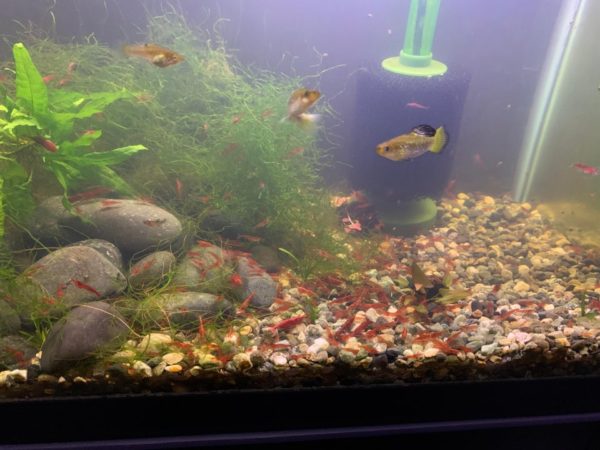
Water Temperature
As for the water temperature, cherry shrimp are quite forgiving and have a large tolerance range. You can keep the water anywhere from 14-30 degrees Celsius or 57-86 degrees Fahrenheit.
pH Level
Low to no nitrate with a neutral pH or one that leans slightly towards alkaline is ideal for the water conditions. Ideally, the range should be somewhere between 6.5 to 8. Peat can be an important addition to the water as it helps lower its pH.
While filling the tank with either a hose or a bucket, it is a good time to check the pH level. You can add buffers to regulate the water, and additions such as peat and driftwood can act as a softener. Cherry shrimp are sensitive to nitrates, so it’s a good idea to look out for that as well.
After cycling the water and ensuring a safe space for your cherry shrimp, you can get ready to put them in! The tank water should be replaced and monitored regularly just for any abnormalities. We’re looking at switching at least 25-30% of the tank water out weekly. As mentioned before, dechlorinate the water as your new cherry shrimp are sensitive to chlorine and metals. Placing the tank anywhere with moderate sunlight during the day and shade at night will do
Cherry Shrimp Tank Landscape
When it comes to picking a landscape for your cherry shrimps, there isn’t much to worry about. Try out the basics, and you’ll be fine.
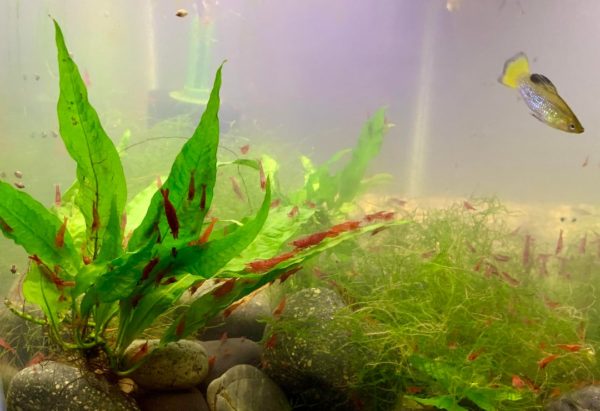
Best Plant for Cherry Shrimp
When choosing plants for your shrimps, it’s good to remember the species’ preferences. Therefore, driftwood and natural aquatic plants are your safest options.
Moreover, considering its feeding habit, encouraging the growth of algae and biofilm in your tank is a good idea as well.
Decorations for Cherry Shrimp Tank
You don’t want to make your shrimps feel uncomfortable in the tank. Therefore try to introduce plenty of hiding places for them at the bottom of the aquarium. Cherry shrimps tend to hover around these places when scared or threatened.
Importantly, quarantine the decorations for a few days before placing them on the tank. That’s better for the health of your shrimp as well as its tank mates.
Feeding Cherry Shrimp
Best Diet For Cherry Shrimp
Red cherry shrimp are scavengers in nature, so they take what they can get in their natural environment. The lucky cherry shrimp that do make it to your protective aquarium can be seen thriving on biofilm and algae. Since they are so easy to care for, they will eat any food intended for aquariums.
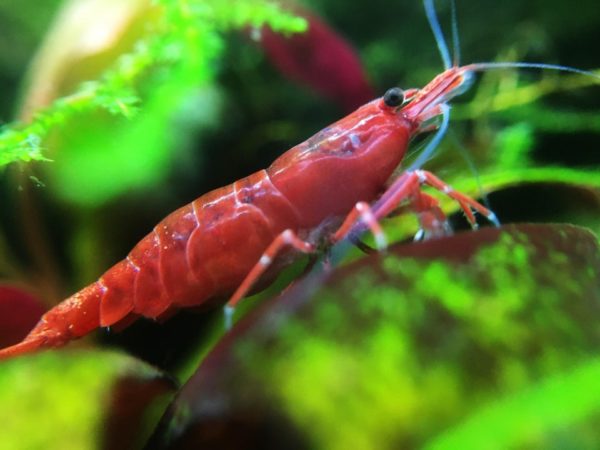
With more time on their hands, owners can even prepare an amalgam of human food that these little shrimps can enjoy. This includes soft-boiled veggies such as cabbage and carrots, but they shouldn’t be the sole diet for the cherry shrimps diet.
Looking for food at your local pet store made just for invertebrates? Pellets make up the bulk of their diet. If you have other fishes as their tank mates, your cherry shrimp won’t run out of food. They are the ultimate cleanup crew; they feed themselves by cleaning up the leftovers of other fish in the tank, thereby making maintenance easy.
We suggest removing leftover pellets and other such food after two hours of being untouched. It will maintain your water chemistry balance and keep the tank environment healthy.
Cherry Shrimp Temperament and Behavior
As said, this freshwater shrimp is quite even-tempered and not aggressive. They go about their day cleaning away the algae and biofilm, taking a walk along the substrate, and generally keeping to themselves. Don’t fear when you see what was once a vivid red shrimp shrivelled into the form of a ghostly and slightly translucent shell.
Cherry shrimp, much like their other shrimp cousins, shed their exoskeleton and float around the tank like a phantom shrimp. Don’t be too eager to clean it out because as uninviting as it sounds to us, the exoskeleton provides necessary minerals when ingested by the shrimp. These are low-maintenance invertebrates that can clean up after themselves.
These active shrimps keep themselves busy day or night, but a pregnant female should never feel threatened, or she could abandon her eggs. So make sure she has plenty of spaces to hide.
Are Cherry Shrimps Lone Or Societal?
Cherry Shrimps are extremely friendly. They prefer staying in groups, and you should try to keep in the company of other shrimps of its species.
Cherry Shrimp Tank Mates
Let’s talk about roommates! Unfortunately, cherry shrimp, or most shrimp for that matter, is at the bottom of the food chain. It means they are often preyed upon and need to be placed with fish that ignore or supplement their existence. You don’t want to wake up one day with your entire shrimp population devoured.
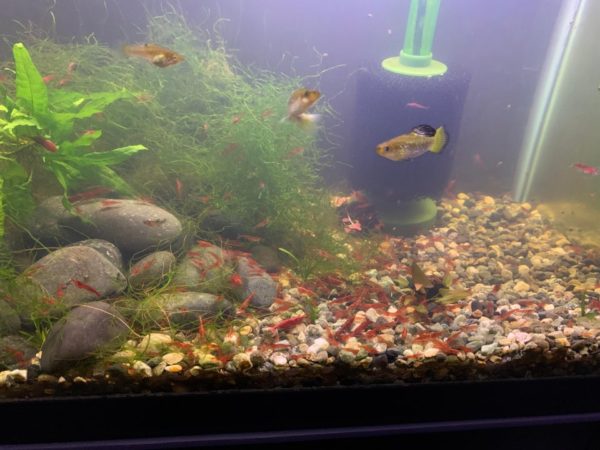
Ideal Cherry Shrimps Tank Mates
Whether or not the fish will leave your cherry shrimp alone has nothing to do with size. Even smaller fish have the potential of being bullies and harming the shrimp. Looking for unaggressive fish is your best bet. What fish can be kept with cherry shrimp? Species such as certain tetras and catfish, African Leaf Fish, Dwarf Gouramis, and sea snails are tank mates that can play nice with the cherry shrimp.
Even with these peaceful buddies, there is still a chance your red cherry shrimp will be mistaken for food. As they have no tools to defend themselves, their best bet is hiding among the plant substrates, so make sure you give them a fighting chance.
Cherry shrimp are a group species and don’t do well independently. It’s recommended to keep at least 10 of them together at once, and hopefully, they will breed a healthy colony. It’s easy to understand why a strong colony will give these little critters more confidence and chances of survival.
Bad Tank Mates for Cherry Shrimps
If you’re looking to place your shrimps with other fish species in your tank, look to avoid:
- Crayfish
- Freshwater crabs
- African dwarf frogs
- Large and aggressive fishes
Breeding Cherry Shrimps
They are relatively easy to breed, so there isn’t a golden ratio in terms of males vs females. However, having more females is ideal. Many experts also suggest building up a good number in your shrimp colony before adding other tank mates to give them a better chance at survival.
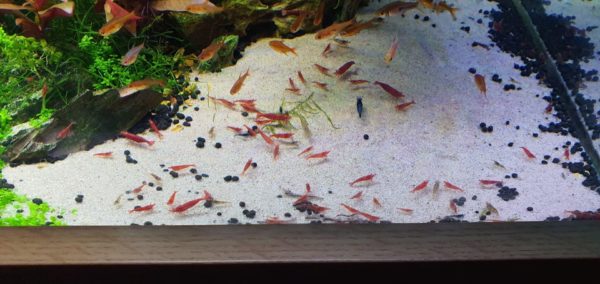
Breeders will tell you that cherry shrimp are among the easiest to breed species of arthropods. Even so, there are still preparatory steps you need to take to increase your chances. We keep emphasizing the importance of plants, and this isn’t so that they can hide from potential predators but also gives them the privacy they require to breed.
Ensure the females are physiologically ready for the task by providing high-quality food with good protein content. Cherry shrimp tend to breed during the summer months, making the water in which they reside warmer. To simulate this, you need to raise the temperature to about 28 degrees Celsius (82 degrees Fahrenheit).
Shrimps around 4-6 months old will hit sexual maturity and start breeding. We suggest letting them acclimate to the new tank environment first, which could take around 4 months. You will know the breeding was successful if you soon see the females carrying eggs under her tail.
Once she lays them, you will also see her fanning the eggs with her tail, so they receive oxygen or scurrying her legs quickly for the same purpose. Don’t get too excited just yet because it will take about a month for you to see the baby cherry shrimp.
Once the baby cherry shrimp are welcomed into the world, you will see they resemble their parents quite a bit. They hide for a little time. You have to take special care of these spices in their early phase of life. Don’t remove them from this environment, as they can be easily eliminated by scraps floating around for food. Parent cherry shrimp teach independence very early on in their household, and they mostly leave the baby shrimp to fend for themselves. Many people wonder if cherry shrimp eat their children, and the answer is no, they do not, but they are pretty hands-off parents.
This is why you need to take extra care and ensure the babies get what they need. You can do so by adding more substrate, moss, and driftwood to give them a little boost. It’s also increasingly important to monitor the other tank mates during this time because even the most non-aggressive and small-sized fish can accidentally consume the shrimp babies for an afternoon snack.
Cherry Shrimp Breeding Level
Easy to Intermediate
Cherry Shrimp Sexual Dimorphism
Distinguishing a female cherry shrimp from a male is fairly simple. Typically, these are the common points of difference between the two genders:
- Males lack a saddle
- Males are also smaller than females in size
- The females of the species have more vibrant color
- The females also have a bigger and rounder belly
- The males are more aggressive
Cherry Shrimp Common Disease And Their Treatment
Diseases in Cherry shrimp are most common when they are in-bred. That’s why it’s important to know about their history before you purchase one from a commercial breeder. Diseased shrimps don’t tend to live for long. Thus, there’s little point in buying something like that.
Facts About Cherry Fish
- They are excellent swimmers
- The species is famous for its ability to change color
- Cherry shrimps don’t have a larva stage
- Their tail acts as a propeller
- They are extremely vulnerable to abrupt changes in temperature
Are Cherry Shrimps Right For You?
For beginners trying to raise a shrimp colony, perhaps start with cherry shrimps. Make sure you keep the tank condition ideal and watch your aquarium come to life with these colorful additions.
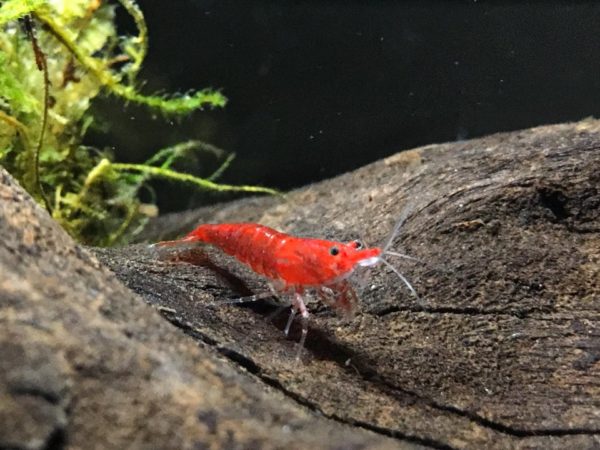
FAQs
How Often Do They Molt?
Molting is fairly common among the species. You can usually expect the adults to molt every four to six weeks.
Are They Easy To Keep?
Cherry Shrimps are fairly easy to keep and great for beginners.
Do They Lay Eggs?
Interestingly, cherry shrimps don’t lay eggs. It differs from most other aquatic species in this aspect.
Conclusion
Cherry shrimp are beautiful invertebrates sought for their red hues. Unfortunately, they are graded according to their pigments (unfortunately) and can vary in price. It’s worth noting that the somewhat less desired cherry and sakura shrimp can adapt to water conditions and changes in the tank more easily than their higher-grade counterparts and are less demanding.
No related posts.
